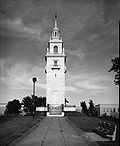| Peabody & Stearns | |
|---|---|
 Peabody and Stearns Boston Office (c.1905) | |
| Practice information | |
| Partners | Robert Swain Peabody, John Goddard Stearns Jr., George A. Fuller, Pierce P. Furber |
| Founders | Robert Swain Peabody, John Goddard Stearns Jr. |
| Founded | 1870 |
| Dissolved | 1917 |
| Location | Boston, Massachusetts |
| Significant works and honors | |
| Buildings |
|

Peabody & Stearns was a premier architectural firm in the Eastern United States in the late 19th century and early 20th century. Based in Boston, Massachusetts, the firm consisted of Robert Swain Peabody (1845–1917) and John Goddard Stearns Jr. (1843–1917). The firm worked on a variety of designs but is closely associated with shingle style. [1]
Contents
- Works
- Georgia
- Maine
- Massachusetts
- Missouri
- Minnesota
- New Jersey
- Pennsylvania
- Rhode Island
- Washington, D.C.
- Notable Peabody & Stearns architects
- Images
- Notes
- References
- Further reading
- External links
With addition of Pierce P. Furber, presumably as partner, the firm became Peabody, Stearns & Furber. [2] [note 1] The firm was later succeeded by W. Cornell Appleton, one of the Peabody & Stearns architects, and Frank Stearns, son of Frank, as Appleton & Stearns. [3]














